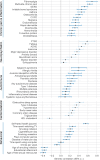This is a preprint.
Genome-wide association study of dry eye disease reveals shared heritability with systemic comorbidities
- PMID: 40166553
- PMCID: PMC11957100
- DOI: 10.1101/2025.03.18.25324218
Genome-wide association study of dry eye disease reveals shared heritability with systemic comorbidities
Abstract
Dry eye disease (DED) affects up to 25% of the adult population, with chronic symptoms of pain and dryness often negatively impacting quality of life. The genetic architecture of DED is largely unknown. Here, we develop and validate an algorithm for DED in the Million Veteran Program using a combination of diagnosis codes and prescription records, resulting in 132,657 cases and 352,201 controls. In a multi-ancestry genome-wide association study, we identify ten significant loci in nine susceptibility regions with largely consistent effects across ancestries, including loci linked to synapse maintenance (EPHA5, GRIA1, SYNGAP1) and autoimmunity (BLK). Phenome-wide scans for genetic pleiotropy indicate substantial genetic correlations of DED with comorbidities, including fibromyalgia, post-traumatic stress disorder, and Sjögren's disease. Finally, applying genomic structural equation modeling, we derive a latent factor underlying DED and other chronic pain traits which accounts for 51% of the genetic variance of DED.
Keywords: comorbidities; dry eye disease; genome-wide association study; heritability.
Conflict of interest statement
No conflicting relationships exist for any author.
Figures





References
-
- Craig J.P., Nichols K.K., Akpek E.K., Caffery B., Dua H.S., Joo C.-K., Liu Z., Nelson J.D., Nichols J.J., Tsubota K., et al. (2017). TFOS DEWS II Definition and Classification Report. Ocul. Surf. 15, 276–283. - PubMed
-
- Wolffsohn J.S., Arita R., Chalmers R., Djalilian A., Dogru M., Dumbleton K., Gupta P.K., Karpecki P., Lazreg S., Pult H., et al. (2017). TFOS DEWS II Diagnostic Methodology report. Ocul. Surf. 15, 539–574. - PubMed
-
- Bron A.J., de Paiva C.S., Chauhan S.K., Bonini S., Gabison E.E., Jain S., Knop E., Markoulli M., Ogawa Y., Perez V., et al. (2017). TFOS DEWS II pathophysiology report. Ocul. Surf. 15, 438–510. - PubMed
-
- Ong E.S., Felix E.R., Levitt R.C., Feuer W.J., Sarantopoulos C.D., and Galor A. (2018). Epidemiology of discordance between symptoms and signs of dry eye. Br. J. Ophthalmol. 102, 674–679. - PubMed
Publication types
Grants and funding
LinkOut - more resources
Full Text Sources
Miscellaneous
